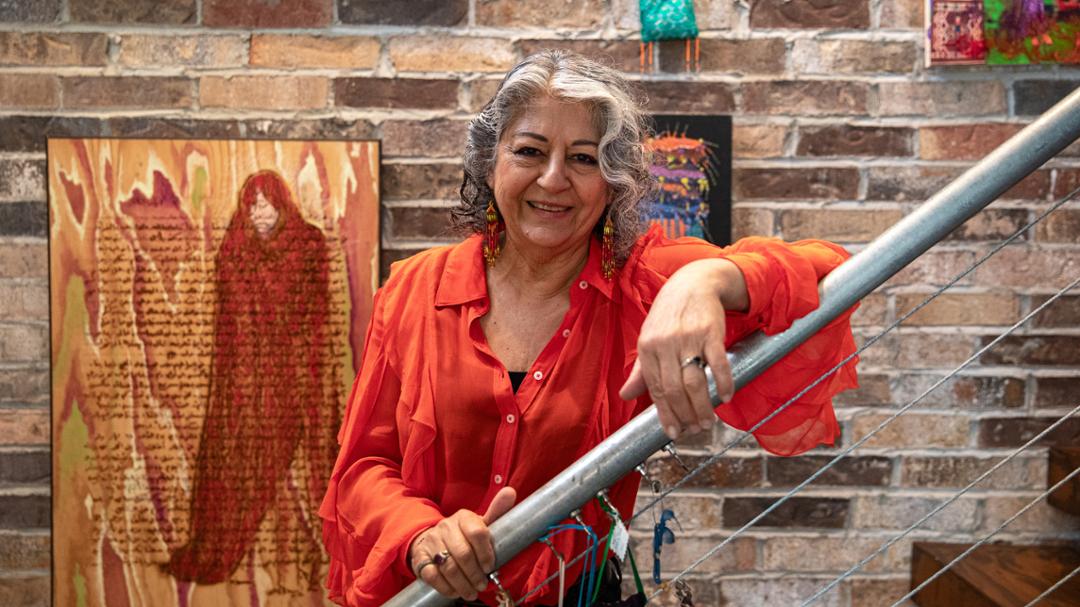Lahib Jaddo explores her world through breathtaking paintings and ecological design at Texas Tech.
Lahib Jaddo’s house is simple from the outside.
The gray river stones accent the white siding and almost would be missed if not for three things: the apricot tree in the yard, the firepit set up for company, and a bright pink door.
Each whisper of the woman living inside.
When you step through the front door, the whisper turns to a vociferous song. The gray and white of the exterior are washed away by bursts of currant, emerald and sapphire reaching off canvases and up from rugs. The smell of jasmine, tobacco and honey linger.
The house smells warm but is comfortably cool.
The Texas Tech University professor’s home gathers together her past and present. It displays her acumen in architecture and her skill in art. She has degrees in both but teaches in the Huckabee College of Architecture.
Guests are drawn toward a kitchen table with colorful chairs and an equally colorful tablecloth. The extent of color should be overwhelming, but it’s not. The interior of the house is modern and sleek. White walls and concrete countertops allow Lahib’s art to take up just the right amount of space.
Lahib sits at the table; one hand cradling her chin while the other traces the threads in the tablecloth.
She is a master of connection, finding common threads in everything.
Iraq
Lahib was born in Baghdad in 1955. Lahib’s father had set aside religion, tradition and expectation, treating life as a blank canvas to be filled. While they lived in a predominantly Muslim society, Lahib’s father viewed religion as something that tied one down. He didn’t want that, and he certainly did not want that for his daughters.
Lahib lived with her parents, siblings, aunt, and grandmother.
“Our culture lives communally,” she said. “It is normal for many generations to live under the same roof.”
Their house was close to the Tigris River.
Lahib’s father was an irrigation engineer who kept the river from flooding the city. Berms were built around the banks, keeping the water below and offering a lookout from above.
Lahib and her younger siblings would perch on the berms, watching the men build boats. Old, young, strong, weak, sick, healthy, tan, tired, cross, gentle, mirthful, irascible and bearish, they all needed work and the wood needed assembling. Lahib would witness the boats turn from a flat concept into a vessel ready for voyage, down the river to places her imagination drifted.
Their family home was four houses from the river.
“The smell of tangerine, orange and eucalyptus take me right back,” she said.
There were citrus trees in the yard, as well as a eucalyptus tree her grandmother particularly loved.
Lahib’s grandmother set the tone for the day. Rising before anyone else, she went through her prayer ritual. This was important to her, the matriarch of the house, even if it was not a shared practice. The reverence she approached the spiritual with was the same devotion she gave to breakfast.
The aroma of toasted pita bread, date syrup and gaimar awoke Lahib and her siblings. They scrambled to the cushions on the patio where the morning’s offering was served up with tea. The meal braced Lahib for the day ahead.
She and her siblings attended a French school run by nuns.
“The best schools in the Middle East are from religious entities in the West,” Lahib said.
While her parents were not religious, they were uncompromising when it came to their children’s education. Lahib was taught in English, French and Arabic, fluent in all three at a young age. She tried to be fluent in the language of prayer, too, as the nuns took the children to the chapel every morning to pray. But Lahib’s greatest revelations did not come in chapel, but rather, when she was creating.
“My mother was a teacher and an artist,” Lahib said.
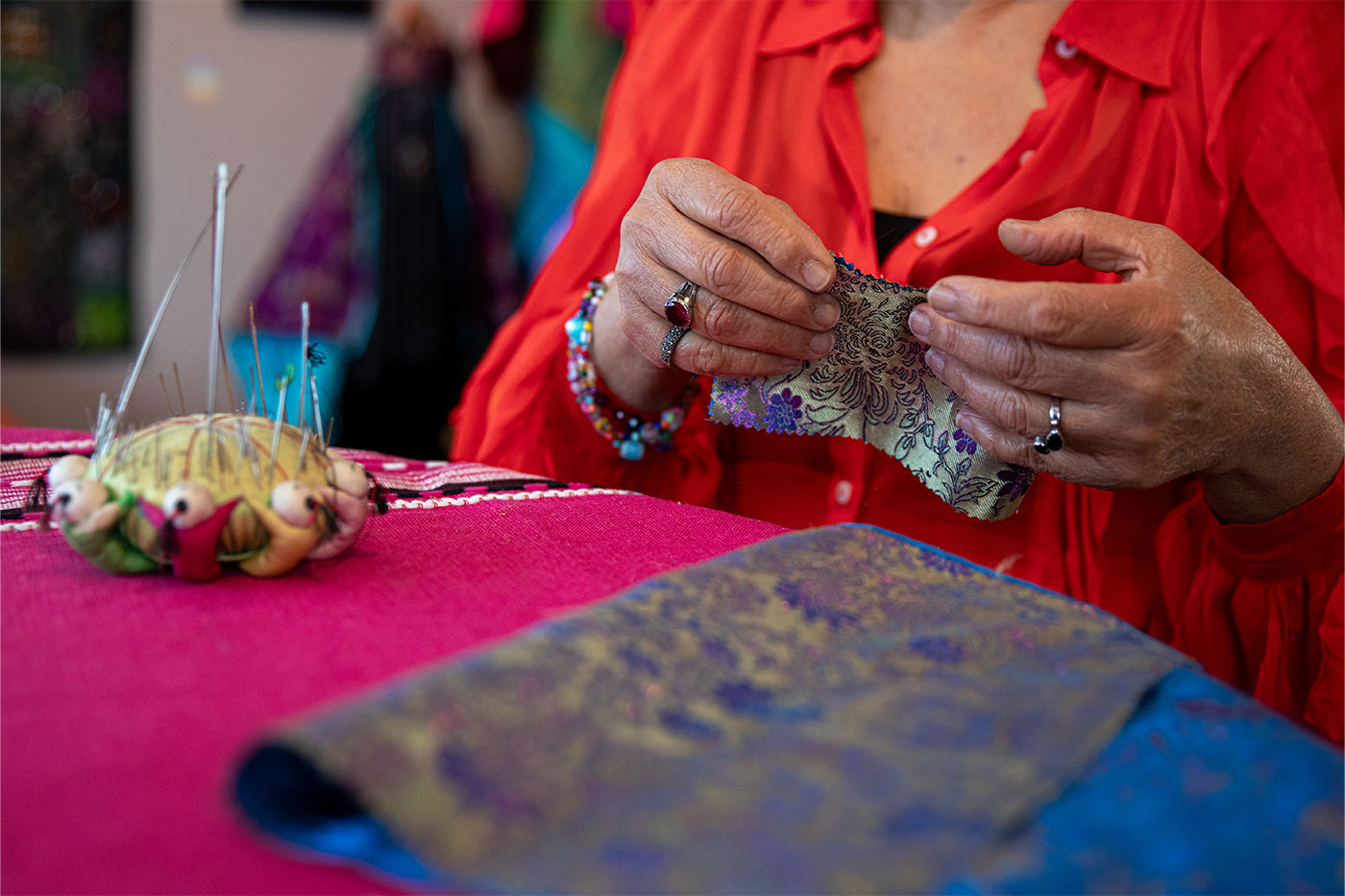
Lahib and her mother wandered around collecting items that didn’t seem to go together. They created collages, ceramics and paintings that joined seemingly unrelated parts of their environment into something beautiful. Lahib saw her home, the river, her school and even the citrus trees as a setting for a meaningful story. What that story was, though, she did not yet know.
1963
Unknown to 8 year-old Lahib, tensions in Baghdad were rising.
Since the end of WWI, Iraq had been saddled with ineffectual leadership backed by the British. In the late 1950s coups replaced the monarchy to establish a Baathist republic.
The Ba’ath Party later gave rise to Saddam Hussein.
Lahib’s father had been an active participant in the former government, using his career to improve living conditions. The Ba’ath Party took power in Baghdad in 1963, executing hundreds of citizens aligned with the previous government.
One night, Lahib came into the living room where her parents sat watching the news.
“We had a black-and-white television,” she recalled. “I looked at the screen and saw Qasim, the previous leader of our country, sprawled on the ground. There was something black coming out of his neck.”
The image would have been more haunting had the newscast been in color. Lahib realized later she had seen Qasim bleeding out.
While blood was still filling the screen, a knock came at the front door. Lahib’s uncle had come with news. The Ba’ath Party had a list of people to execute next and Lahib’s father was on it. He was to be hanged. The room became chaotic, panic written on the adults’ faces. Lahib’s mother shooed her out of the room.
Only later would Lahib learn what happened.
Her uncle disguised her father in Kurdish attire and snuck him out of the city. They drove north into the mountains where her father hid in a cave for months.
“Our family was very well off,” Lahib said. “My parents made a good living. Overnight, my father went from Persian rugs to sleeping on dirt.”
Several political refugees made their home in the mountains. When the caves were bombed, which they regularly were, the men took the pots used for cooking and wore them as helmets. When the debris settled, they went back to cooking.
Back home, the family believed Lahib’s father to be dead. Their uncle was unable to travel back to Baghdad or send any correspondence. Lahib’s mother was pregnant with her fifth child and was in mourning. The family now lived on whatever she could provide because their father’s assets had been frozen.
One day, another knock came at the front door.
“In the Middle East there are people known as Qalandar, religious Sufis who meditate and live in the wild,” Lahib explained. “If they knock on your door, you offer them food.”
On this day, a Qalandar appeared on the family’s front doorstep. Lahib’s mother was already struggling to support herself and four children but was not going to send them away. As she offered food to the visitor, the Qalandar slipped a note into her hand.
“I’m alive. Come see me in Iran.”
2024
Lahib looks up from the threads in her tablecloth.
She walks to her kitchen, explaining that talk of her childhood has made her hungry. She pulls out pita bread along with a bright yellow jar of date syrup, and sure enough, gaimar.
Assessing the shelves in the refrigerator, she lets out a huff of pride when she finds what she’s searching for. She picks up another jar and nudges the fridge door closed with her shoulder, bringing the food to the table.
The mystery jar contains pickled turnips.
“My grandmother used to make these,” Lahib said. “The pink color is what inspired my front door.”
She takes a bite, letting the flavor settle. Her face becomes pinched.
“Oh dear, that’s awful!” she laughs. “They need another few days.”
The syrup effortlessly chases down the soured turnips. Lahib explains the pita-based breakfast is still her favorite. She teaches a design lab at the Huckabee College of Architecture every Monday, Wednesday and Friday morning. She often eats this breakfast on her way to campus; it’s sweetness a memory from years ago.
Lebanon
After meeting their father in Iran, the family moved to Lebanon. The country offered a fresh start. Its politics were free form, the mountains snow-capped and the coastal towns were lush with banana and orange groves. They lived in Beirut, the capital. There was a thriving community of Iraqi people who also had fled persecution.
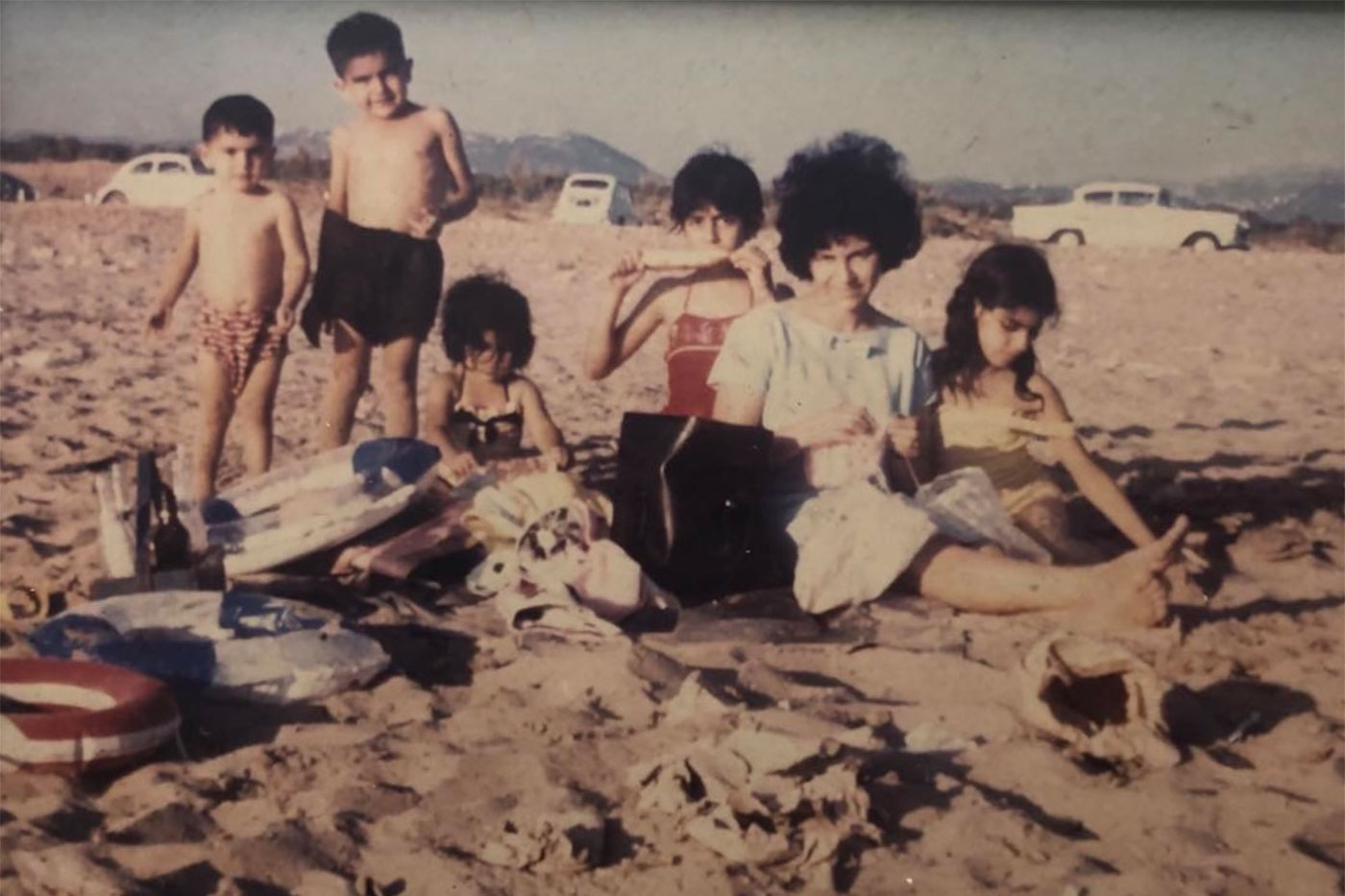
Lahib created strong friendships in Beirut. She spent weekends snow skiing or snorkeling with friends, traveling up and down the coast and camping. After finishing high school, Lahib and her sister studied at the American University of Beirut.
Beirut had furthered Lahib’s passion for art. The cultural offerings and open minds of the city were a hotbed of artistic expression. However, Lahib’s father was concerned she would become the stereotypical poor starving artist, so he suggested architecture when it came time for university. Lahib, being a three-dimensional thinker, agreed it could be a good middle ground.
“Architecture became my escape,” she said. “I imagined my designs inhabiting peaceful places of green landscapes.”
The architecture program at the American University of Beirut was a curriculum run by a global faculty. Architecture history was taught by an Austrian professor; design by a professor from Sausalito, California; a Greek professor taught higher levels and the department’s location was perched on the edge of a green landscape of oleander and pine overlooking the Mediterranean and backed by the mountains.
Lahib had known both war and peace. Her designs were a small but significant way to share the peace she now enjoyed, particularly in a part of the world where people had come to seek rest.
All of that ended in 1975 when the Lebanese Civil War began. A clash between Christians and Muslims demolished the peace Lahib and her family had enjoyed for a decade. Her parents returned to Iraq, where they received amnesty. They desperately wanted Lahib and her younger sister to return with them, but Lahib had no desire to return to the culture of Iraq where women’s voices were squelched.
Her campus may have been bombed, but in many ways, she felt safer there than in Iraq.
“Living in a war zone while studying architecture impacted my understanding of the practice in a strange way,” she said. “It became my escape from the harsh reality of human bloodthirstiness. Hiding in bomb shelters then running to class gave life an unrealistic edge and a contrast to my designs.”
During this time, Lahib met the man who would become her first husband. He also studied at the American University of Beirut, preparing to become a doctor. The two dreamed of moving to the west and practicing medicine and architecture.
Those dreams became reality when the two married and moved to New York in 1977. With the war in Lebanon still raging, they knew their best path forward was leaving the Middle East behind.
Lahib’s husband started his residency at Albany Medical Center and the couple moved into housing at Rensselaer Polytechnic Institute in Troy, New York, where Lahib finished her bachelor’s degree.
“Oh, it was so cold!” Lahib said. “I hated it.”
The move was a huge culture shock for the couple, but even more so for Lahib who was disheartened by the lack of women in the architectural program. Architecture had already seen a cultural renaissance in the Middle East. There were as many women as there were men in the program in Beirut.
“I was now perceived as the outsider,” Lahib said.
Lahib struggled to understand the English used in New York. She was one of the only women in class and certainly was the only woman of color. On top of this, she was one of the only married students, making it hard to socialize outside of class.
Lahib was lonely.
When the snow melted, she found a few pleasures in her surroundings.
“I took my painting sets and walked around the hillside behind our house,” she recalled.
“I put my canvas up and painted whatever was in front of me. It was landscape painting, but it helped pass the time and it was pleasurable.”
Lahib finished her bachelor’s degree and went to work at an architectural firm in Troy. Soon after, her husband took a job with UMC Health, and they left the cold behind.
2024
Lahib is still drizzling syrup onto pita as she imitates shivering in the New York winters. She came to Lubbock in 1980; clearly the hot and dry weather has agreed with her. The house she now lives in is considerably new, not at all the home she settled in 44 years ago.
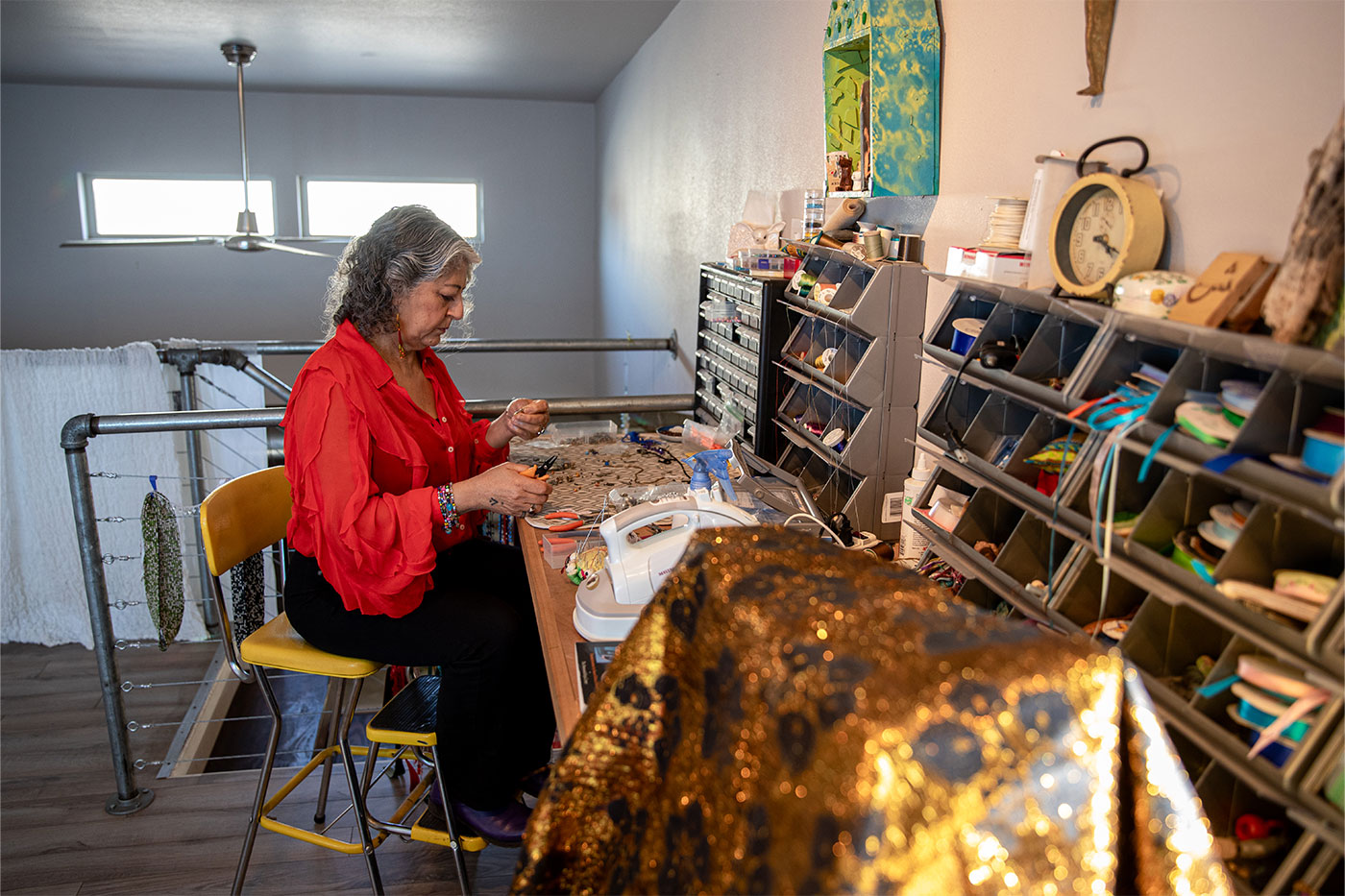
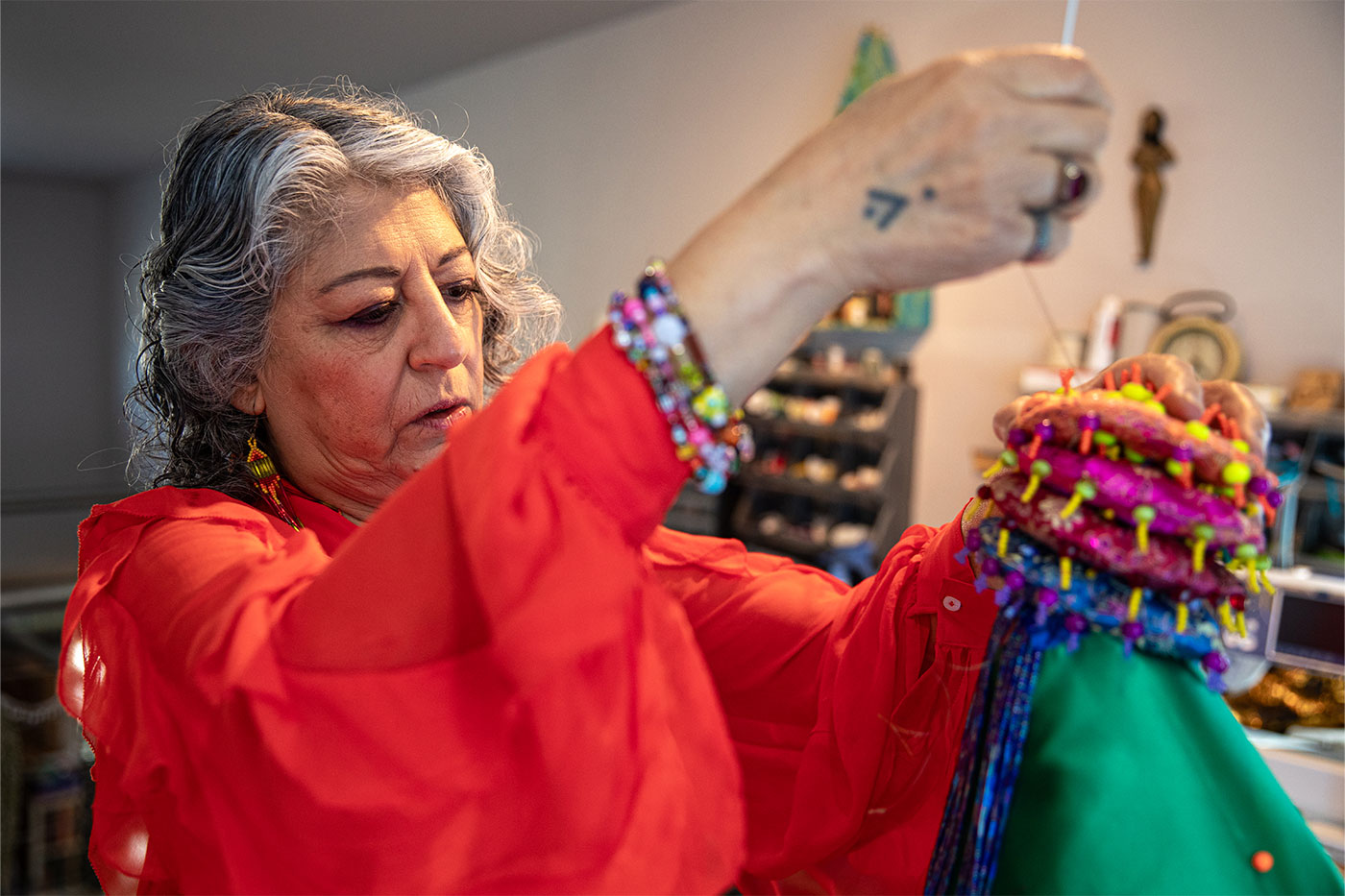
The house with its exposed beams and air ducts seems like the house of an architect.
There are only a few rooms; there are no signs of other people living in Lahib’s artistic retreat. The space is uniquely her own. Many paintings on the walls portray semi-arid climates with canyons in the background. It’s hard to know which represent the Middle East and which represent West Texas.
“The climate in Lubbock is a lot like Baghdad,” Lahib mentions as she finishes off the last bite of pita.
“But there are things about Lubbock that are very different.”
1980
While Lahib was a practicing architect, she moved to Lubbock as a housewife. They moved for her husband’s job and Lahib figured she’d eventually find work. But shortly after moving, Lahib had a daughter. Then she had a son. Soon, she was home full-time with two young children.
“As a doctor’s wife, we socialized with other doctors and their wives,” Lahib said.
Her husband gravitated toward spending time with other Middle Eastern couples, which was fine with Lahib, but she also wanted to meet different kinds of people. The more time went by, the more insular their social life became.
“They observed many of the religious and gendered ideologies my parents had worked so hard to shield me from,” she said. “It felt like I was moving backwards.”
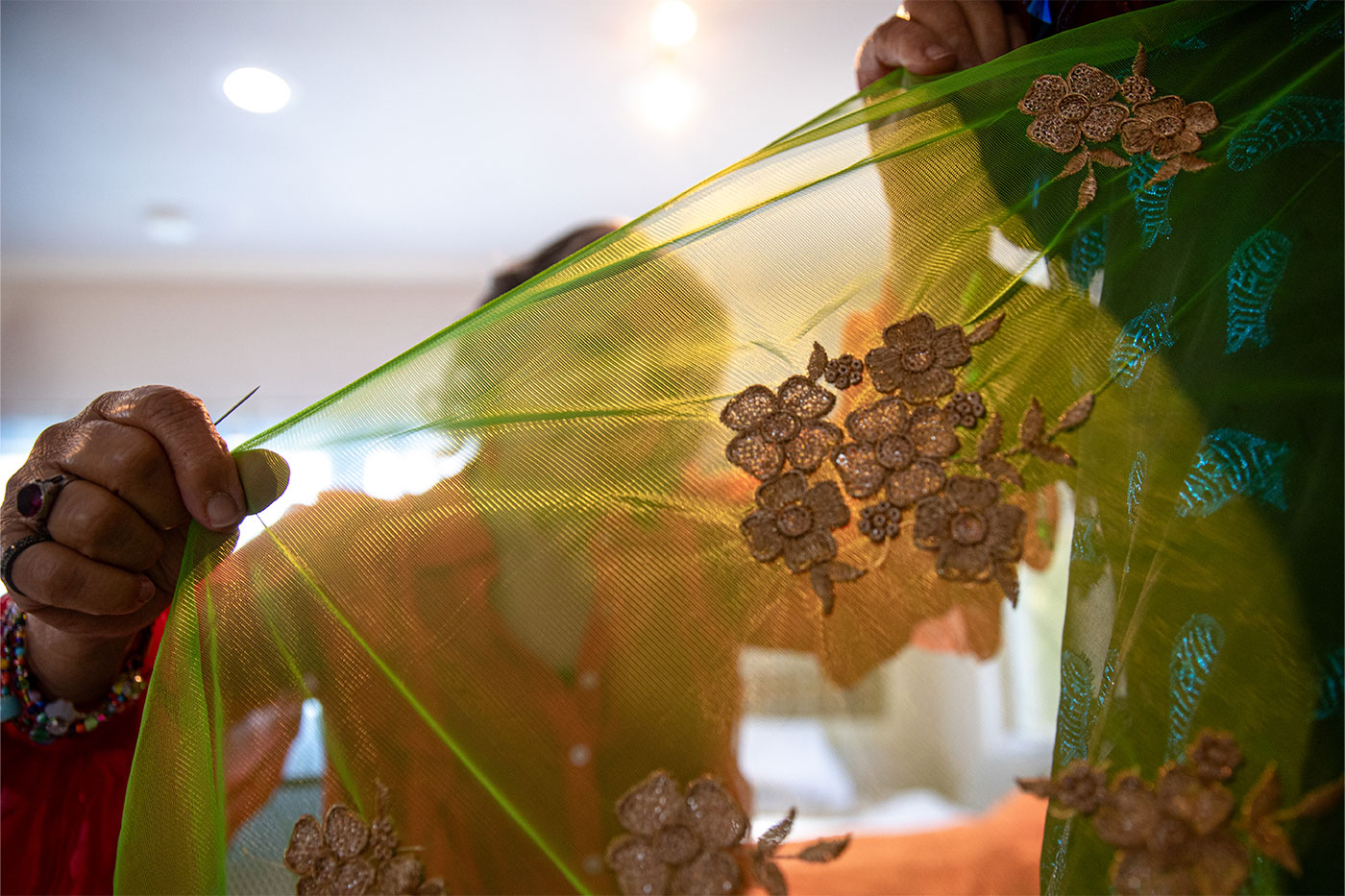
Desperate for intellectual stimulation, Lahib decided to go back to school. She investigated graduate art programs at Texas Tech. When she took the idea to her husband, he said, “What are you going to study art for? It’s worthless.”
This was the beginning of the end for the couple.
Rather than arguing, Lahib decided she’d find something worthwhile, as her husband called it, and pursued a master’s of architecture. Texas Tech’s department of architecture had just started its graduate program and Lahib was one of its first students.
Lahib and her husband divorced during this time. Her graduate education became much more important now that she was raising two children without a second income.
Lahib graduated in 1987 and celebrated with her children who were 7 and 5 years old. She was qualified for a job with any architectural firm where she wanted to work. But rather than leave Lubbock, she then did what she always wanted – to study art.
1990
“Architecture is a form of art,” she said. “But not the only form.”
Lahib believes in being a well-rounded artist, and for her, that meant more than architectural training alone. She started a Master of Fine Arts the very next semester and graduated in 1990.
“I found my voice,” she said of her time in art school. “Before that time, I would paint anything and everything. And that was fine because for a while art was my therapy. But when you go to school, you must find your focus. You’re encouraged to define the lens you see the world through.
“I found that. And it’s amazing that 33 years later, I still have that same voice. I see the world with my own eyes as a woman who was raised in a conservative culture but is finding freedom. And the freedom I’m finding is limitless. Whether it’s how I hold myself in the world, how I wear my clothes, how I think, how I speak – all those things come together. I paint how a woman finds her place in the world.”
Once Lahib found that lens, she never looked back. Her paintings, every one of them, feature a woman. Sometimes she is old, sometimes she is young. Sometimes she is wrapped in color and other times she is in black. The women are surrounded by rivers, mountains, birds, plants, boats, food and countless other treasures within their frames.
“Each of them tells a story; each of them shows a different aspect of womanhood,” she said.
Her paintings represent two worlds – the one she lives in and the one of her imagination. One is an inner world, a psychic and spiritual place. The other world is grounded in reality. The women fight the tension between the two. Not unlike Lahib as she stood on the berm beside the Tigris, imagining what existed downstream.
Lahib fully gave herself to cultivating her artistic voice during the 1990s. She painted more than 800 pieces during this time. When her daughter turned 14, she began modeling for her mother’s paintings. Her mother would dress her up in colorful skirts, shawls and scarves.
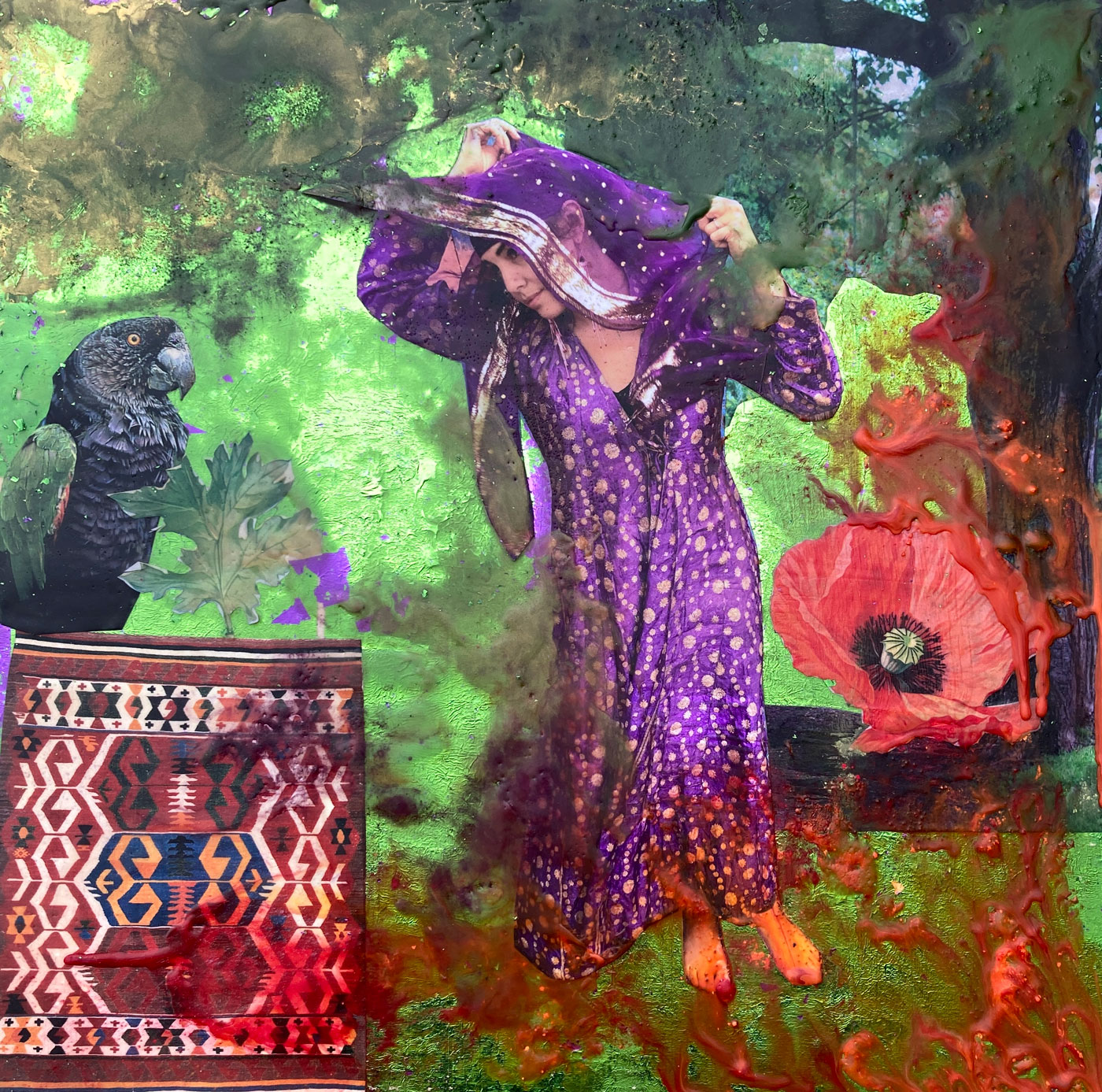
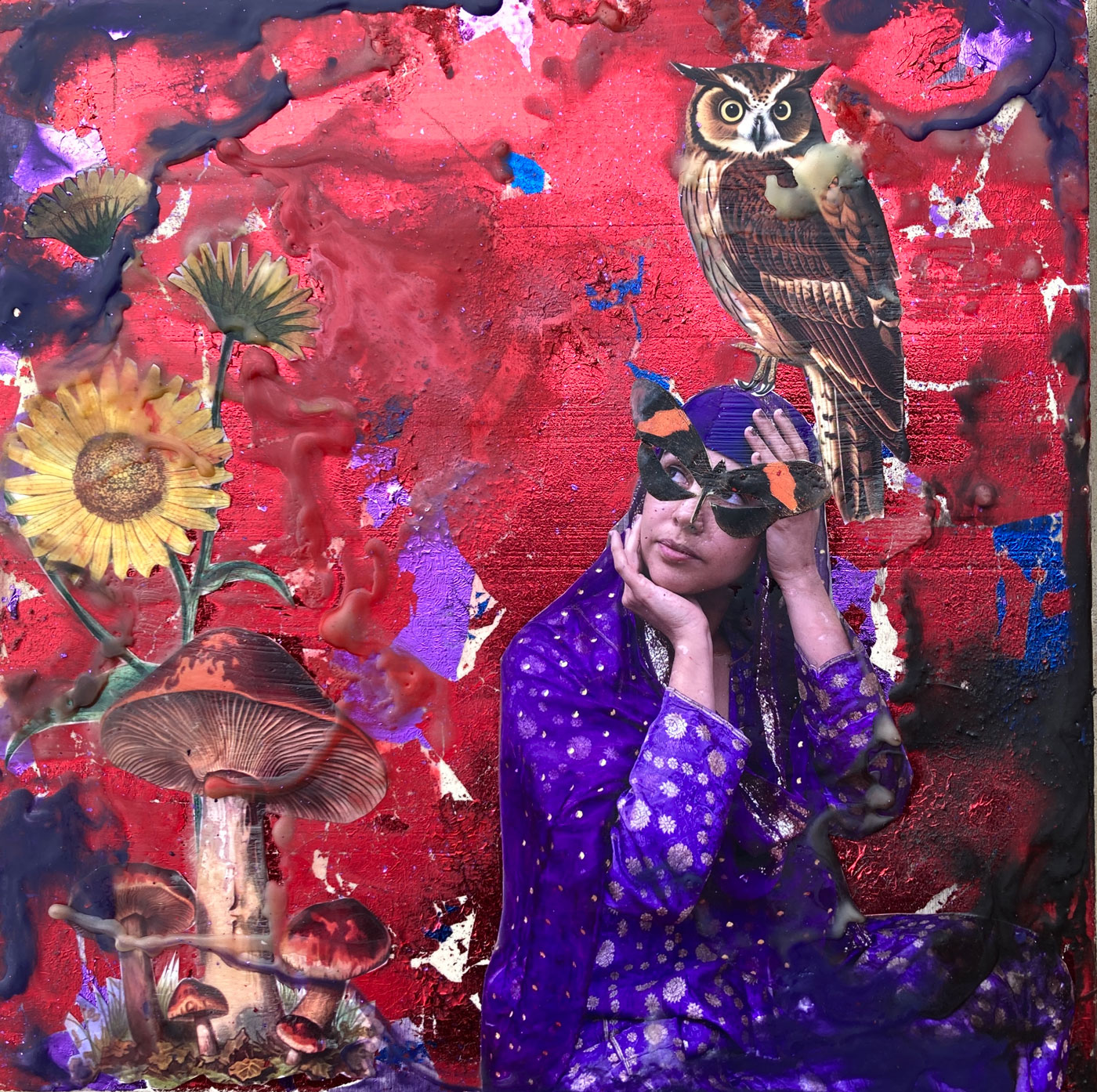
“I could always tell how my mother was feeling based on the poses she had me do,” her daughter said. “When she asked me to pose with arms outstretched, I could feel her strength.”
Lahib and her daughter would go on long drives throughout the Caprock looking for places that mirrored the landscape of Lahib’s childhood.
1997
One day, a friend of Lahib’s who was a faculty member in the Huckabee College of Architecture gave Lahib a call. He asked her to consider teaching the art courses at the college. Virginia Mahaley Thompson, who taught the courses, had just retired, and while computers were changing the practice of architecture by this time, the standard was still drafting with pencil. It was imperative architects master drawing and even watercolor.
Lahib was perfectly positioned for the job.
“There used to be four art courses every architecture student took,” Lahib said. “This helped guide their designs and allowed them to add texture, depth and materials.”
For the first time in a long time, it seemed things were coming together. Lahib was using all her training in a way that not only fulfilled her, but also gave back to students. She realized she had a knack for helping discover students’ strengths. She would mentor and guide them toward success.
As her professional life was coming together, her personal life was collapsing. At the turn of the century, Lahib encountered more personal heartbreak. A second romantic relationship reached its limit, leaving Lahib depleted.
“I was completely empty,” she said.
2024
“I don’t make art to make pretty things,” Lahib said. “I make it because it helps me understand my life.”
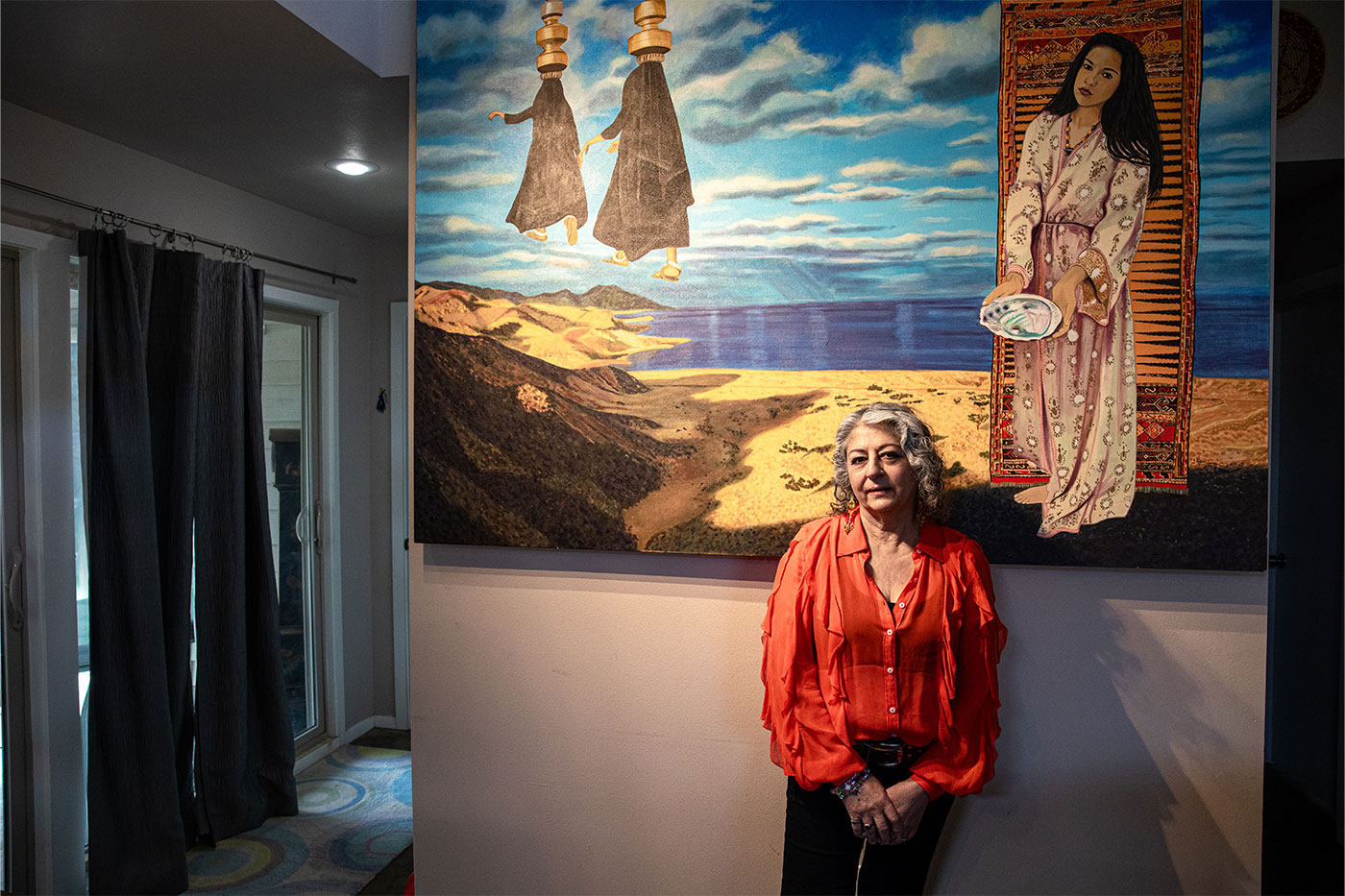
One of the paintings that hangs prominently on Lahib’s wall is a piece she recently bought back from a gallery. She painted it in 1995. In the center is a young woman dressed in Middle Eastern attire, bright colors cover her from head to toe. Next to her is a Persian rug but it is upright, like a door.
“She’s deciding whether to go through it,” Lahib says.
On one side of the canvas are older women dressed in black. But what lies beyond the makeshift door, well, that is in the eye of the beholder.
For Lahib, what lay beyond was solitude and healing.
“I gave up love, at least the romantic notion of it,” she said. “I was exhausted.”
During this time Lahib’s women took on new forms. The paintings explored women as mothers, mirages and even mermaids. The latter were inspired by Lahib’s sense of suffocation in relationships that were not meant to be, the feeling of being underwater.
Along her journey of prioritizing her voice once again, her paintings take on more hues of green – a rebirth of sorts.
A New Century
In 2003, the then-dean of the college, Andrew Vernooy, noticed Lahib’s dedication to her students and the quality of work in her courses. He looked at her resume and realized the college could use more of her influence.
He encouraged her to pursue a tenure track position and Lahib became an associate professor, teaching art and drawing, but other design classes as well.
Lahib encouraged students to find their own voice through architecture. She learned what her students were interested in and helped channel those interests into their designs. She taught architecture as art. For Lahib, the two work together. They’re two parts of her life she has gathered to make something beautiful.
Over the years, Lahib has become a fixture in the architectural and art communities of Lubbock, of which there is much overlap. Most faculty members from the J.T. & Margaret Talkington College of Visual & Performing Arts and the Huckabee College of Architecture have been invited into her home at some point or another.
“The one with the pink door!” many faculty members recall.
Not unlike gathering materials for art projects with her mother, Lahib remains a master of connection. She brings people together, often around her firepit and other times around her kitchen table.
In 2016, Lahib officially retired. However, it was only a few years until Dean Upe Flueckiger was on the phone asking her to come back part time. Lahib missed her students and agreed to take on one class.
She was named Professor Emeritus by the college in 2023. Students continue to learn from her unique point of view and skill set.
“Professor Jaddo is a kind person who challenges me,” said Lupita Gutierrez, a second-year student in the college. “Not many of my professors have degrees in both architecture and art. Because of this, Professor Jaddo can explain things from multiple angles if a student isn’t grasping a concept at first.
“A lot of architecture is incredibly modern, but Professor Jaddo has helped me grow as an organic designer. She has taught me how to bring my environment into what I design and how to embrace what is around me.”
2024
There is only one thing in Lahib’s home that is not awash in color – Lahib.
She is dressed in black, a stark juxtaposition within her own space.
“I lost my son in 2020 to cancer,” Lahib says tenderly. “It was a life changer. You must learn to live with that; you must try to find your joy again.”
In Iraqi culture, women can begin to dress in all black as they turn 50 years old. It’s a cultural norm, and one Lahib took on somewhat subconsciously.
“As you get older, you’re mourning often so you just stick with black,” she said. “It’s a way to remember the dead.”
However, in the past weeks, Lahib began wearing color again.
“I think my son would like that,” she said.
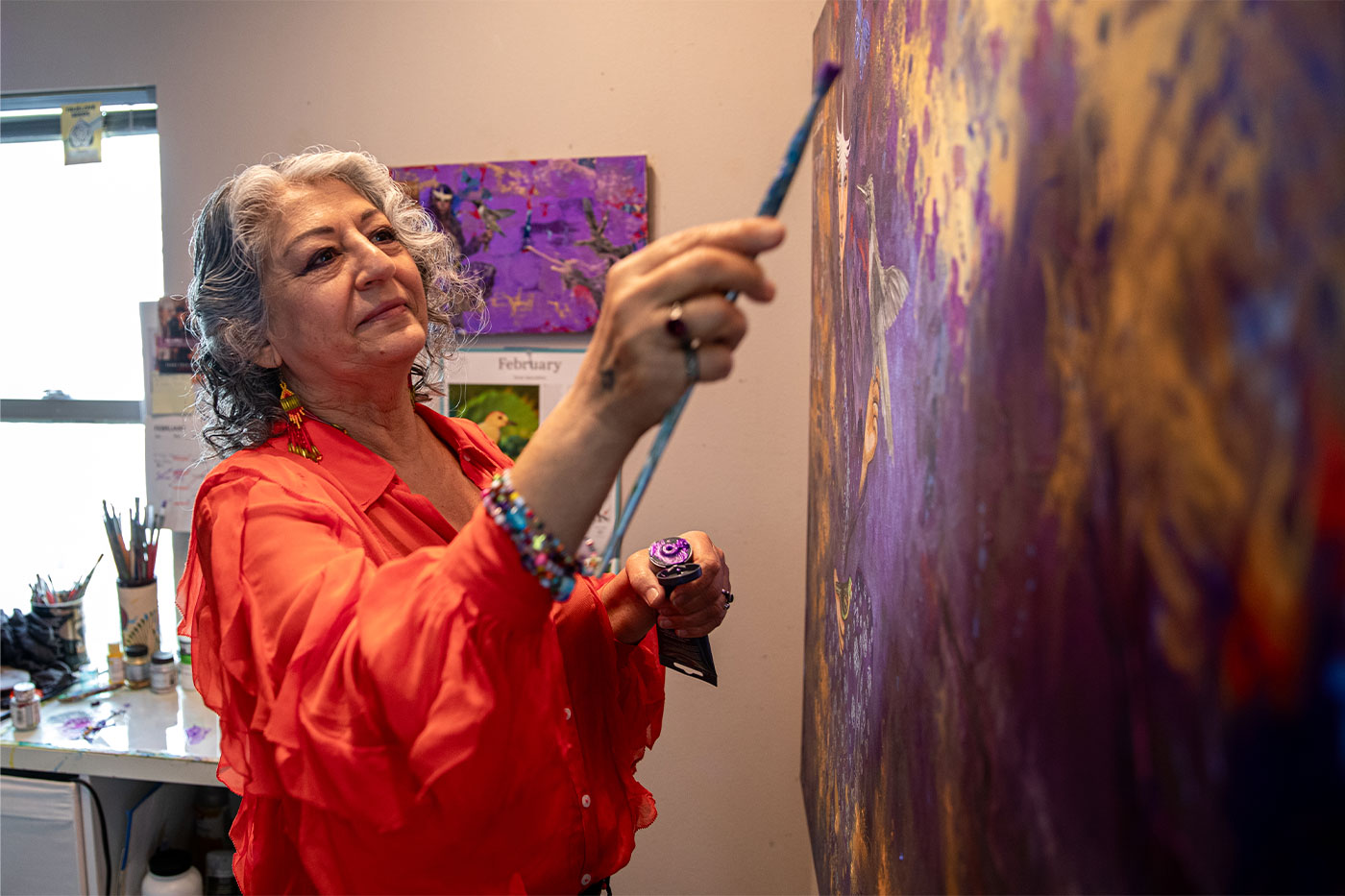
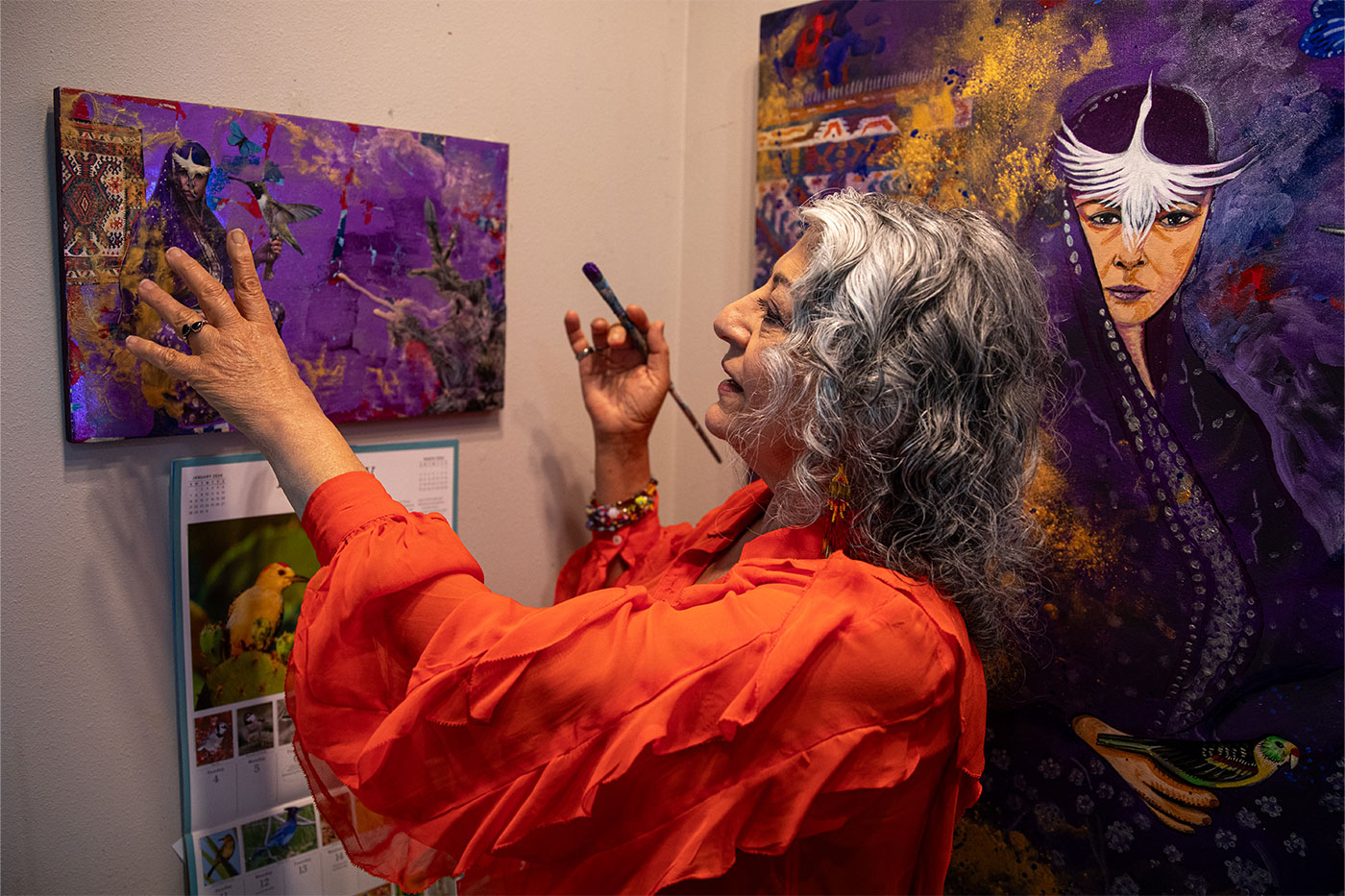
Her son loved citrus trees. He taught his mother the four Ds of pruning, to look for dissecting, diseased, dead or downward pointing limbs. The apricot tree in her front yard was one he helped her grow.
When it bears fruit, Lahib shares it with everyone on her block.
While the inside of her home contains many colors, it is the splash of bright orange and green in late summer that Lahib longs for most. And while the color hasn’t come this year, she holds onto the hope that it will.
“We choose what we hold onto,” she said. “I choose to hold onto joy.”

